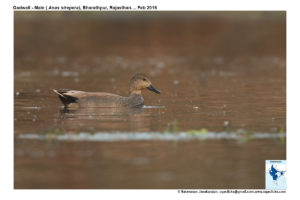Gadwall

Gadwall Anas strepera
Etymology:
- Anas : Latin word for Duck
- Strepera: Latin word streperus – Noisy, Loud
Vernacular Names : Sind: Burd, Buari, Buhar, Hindi: Myla, Bhuar, Beykhur, Sans: Malin hansak, Pun: Gaidwal, Bi, Nepal: Myle, Ben: Peeing hans, Ass: Saru/Xaru mugi hanh, Mani: Thoidingnam, Guj: Luhar, Mar: Malin badak, Sonula, Te: Yella repalla batu, Mal: Gadwal eranda
Distribution in India: Widespread Winter Visitor.
Description: Size of 39-43 cm. Medium-sized, rather nondescript dabbling duck, with mid-sized, slender bill and steep forehead; adult male has greyish-brown head, sometimes suffused cinnamon on forehead and chin, with grey mantle, back and flanks, vermiculated black and white, black upper breast, white lower breast and belly freckled dark, and grey-brown tail with black coverts both above and below; bill grey, sometimes with orangish patches, legs yellowish orange and eyes brown. Female has head and neck buffish brown, streaked darker, with paler chin and upper breast, but darker forehead, crown, nape and diffuse eye stripe, and body mainly warm brown, heavily scalloped darker, especially over flanks, with whitish rear underparts, bill is greyish or greyish black, with dull orange patches, legs and feet yellowish to grey, and eyes brown. White speculum in both sexes distinguishes this species, although more restricted in female, bordered with black in front and contrasting with warm chestnut wing-coverts. Male has eclipse plumage that is very similar to female, but wing pattern remains more striking.
Habitat: It is found in various types of freshwater or brackish wetlands, particularly shallow ones with abundant vegetation, including slow-flowing rivers, lakes, reservoirs, deltas and lagoons.
Food Habits: It eats seeds, leaves, roots and stems of aquatic plants, especially green parts of plants, particularly submerged or emergent vegetation. During laying period, female will feed predominantly on macro-invertebrates, especially cladocerans, but also including insects and gastropods. . Food normally obtained underwater by head dipping and upending, rarely from surface; occasionally grazes by walking on land. Kleptoparasitism of other waterfowl like Red crested Pochard is also observed.
Breeding Habits: They breed in Central and North Europe during April- June. Generally monogamous, with pair formation commencing late Jul–Aug, but continuing until May, with pair-bond terminating soon after laying completed, but may persist until hatching. Nest is made with grass and dry leaves, lined with down, built on ground in thick vegetation sometimes in open, albeit typically within colonies of terns and gulls. Females often faithful to previous nest-site, especially if previous attempt was successful .Lays a clutch of 8–12 eggs . The incubation period is 21–27 days by female alone. The fledging period is 48–63 days. All chicks are Precocial and leave the nest soon but tended by parents even after they leave the nest till they fledge.